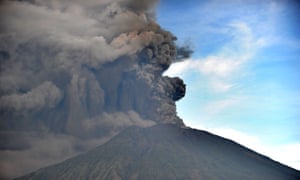
A second eruption in less than a week of the Mount Agung volcano in Bali has intensified the watch for a more serious explosion.
The volcano rumbled into life with a series of eruptions that temporarily disrupted some international flights to the popular Indonesian island tourist destination.
Mount Agung erupted on Saturday evening and three times early Sunday, lighting its cone with an orange glow and sending ash 4,000 metres into the atmosphere. The ash clouds have been moving toward the neighbouring island of Lombok, a direction that is away from Bali’s airport, where nearly all scheduled domestic and international flights were continuing on Sunday.
An exclusion zone extending up to 7.5km from the crater remains in place, following the evacuation of more than 185,000 people after an eruption in September, and authorities have warned anyone remaining within it to leave the area. About 25,000 to 30,000 people are reportedly still unable to return home.
There had been some effect on with flights from airlines including Virgin Australia, Qantas, KLM and Jetstar were affected although many either continued their services or resumed them after a pause. Travellers were advised to check with their carrier.
Mount Agung erupted on Tuesday, forming a 700m ash cloud, which authorities said was “steam driven”.
On Saturday Indonesia’s National Disaster Mitigation Agency said the ash column from Mount Agung rose 1,500m following an eruption that began about 5.30pm and continued for several hours. Villages close to the volcano were coated in a thin layer of ash.
Disaster agency spokesman Sutopo Purwo Nugroho said ash clouds were moving to the south-west, away from the international airport, which remained open. The volcano’s alert status has not been increased from the second highest level and authorities said the island remained safe.
The September eruption was the first sign of activity by Mount Agung in more than 50 years and prompted the highest alert level. In 1963 a major eruption killed about 1,100 people.
The volcano is Bali’s highest peak and a popular hiking destination for tourists, who have been warned to stay away for now. Several villages that rely on the tourism trade are within the exclusion zone and fear for the economic impact on their livelihoods.
Source:-.theguardian.



